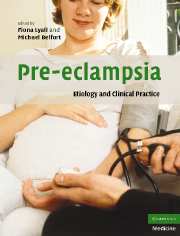Book contents
- Frontmatter
- Contents
- List of contributors
- Preface
- Part I Basic science
- Part II Clinical Practice
- 17 Classification and diagnosis of pre-eclampsia
- 18 Measuring blood pressure in pregnancy and pre-eclampsia
- 19 Immune maladaptation in the etiology of pre-eclampsia; an updated epidemiological perspective
- 20 Genetics of pre-eclampsia and counseling the patient who developed pre-eclampsia
- 21 Thrombophilias and pre-eclampsia
- 22 Medical illness and the risk of pre-eclampsia
- 23 The kidney and pre-eclampsia
- 24 Management of mild pre-eclampsia
- 25 Management of severe pre-eclampsia
- 26 The differential diagnosis of pre-eclampsia and eclampsia
- 27 Complications of pre-eclampsia
- 28 Central nervous system findings in pre-eclampsia and eclampsia
- 29 Pathogenesis and treatment of eclampsia
- 30 Anesthesia for the pre-eclamptic patient
- 31 Critical care management of severe pre-eclampsia
- 32 The role of maternal and fetal Doppler in pre-eclampsia
- 33 Pregnancy-induced hypertension – the effects on the newborn
- 34 Medico-legal implications of the diagnosis of pre-eclampsia
- Subject index
- References
17 - Classification and diagnosis of pre-eclampsia
from Part II - Clinical Practice
Published online by Cambridge University Press: 03 September 2009
- Frontmatter
- Contents
- List of contributors
- Preface
- Part I Basic science
- Part II Clinical Practice
- 17 Classification and diagnosis of pre-eclampsia
- 18 Measuring blood pressure in pregnancy and pre-eclampsia
- 19 Immune maladaptation in the etiology of pre-eclampsia; an updated epidemiological perspective
- 20 Genetics of pre-eclampsia and counseling the patient who developed pre-eclampsia
- 21 Thrombophilias and pre-eclampsia
- 22 Medical illness and the risk of pre-eclampsia
- 23 The kidney and pre-eclampsia
- 24 Management of mild pre-eclampsia
- 25 Management of severe pre-eclampsia
- 26 The differential diagnosis of pre-eclampsia and eclampsia
- 27 Complications of pre-eclampsia
- 28 Central nervous system findings in pre-eclampsia and eclampsia
- 29 Pathogenesis and treatment of eclampsia
- 30 Anesthesia for the pre-eclamptic patient
- 31 Critical care management of severe pre-eclampsia
- 32 The role of maternal and fetal Doppler in pre-eclampsia
- 33 Pregnancy-induced hypertension – the effects on the newborn
- 34 Medico-legal implications of the diagnosis of pre-eclampsia
- Subject index
- References
Summary
Introduction
Pre-eclampsia is a pregnancy-specific condition characterized by placental dysfunction and a maternal response featuring systemic inflammation with activation of the endothelium and coagulation. This multifactorial disease presents as a syndrome of symptoms and signs, with associated hematological and biochemical abnormalities. Most consider hypertension and proteinuria to be the hallmarks of pre-eclampsia, but the clinical manifestations of this syndrome are very heterogeneous. Some women develop severe maternal disease requiring intensive care, whereas others remain asymptomatic with mild hypertension and proteinuria. Approximately one in six babies born to mothers with pre-eclampsia is very preterm. In contrast, two-thirds are delivered after 37 weeks, most of whom are normally grown, healthy babies. It is the very nature of the condition that creates difficulties in classifying pre-eclampsia precisely.
Over the decades a number of classifications have been promoted by different groups of experts or representative bodies (Anonymous, 1990, 2000, 2002; Brown et al., 2000; Davey and MacGillivray, 1988; Helewa et al., 1997; Hughes, 1972; Redman and Jefferies, 1988). This range of definitions has served to confuse clinicians and researchers as to the most appropriate definition to use (Chappell et al., 1999; Harlow and Brown, 2001). The most recent classification proposals are more closely aligned, with some commonality in terminology and criteria for abnormal blood pressure and proteinuria. It is now widely accepted that gestational hypertension is the presence of de novo hypertension (usually diastolic blood pressure >90 mmHg and/or systolic blood pressure > 140 mmHg) occurring in the second half of pregnancy and pre-eclampsia is the combination of gestational hypertension with new proteinuria (Anonymous, 2000, 2002; Brown et al. Brown et al., 2000; Helewa et al., 1997).
- Type
- Chapter
- Information
- Pre-eclampsiaEtiology and Clinical Practice, pp. 243 - 257Publisher: Cambridge University PressPrint publication year: 2007
References
- 1
- Cited by



